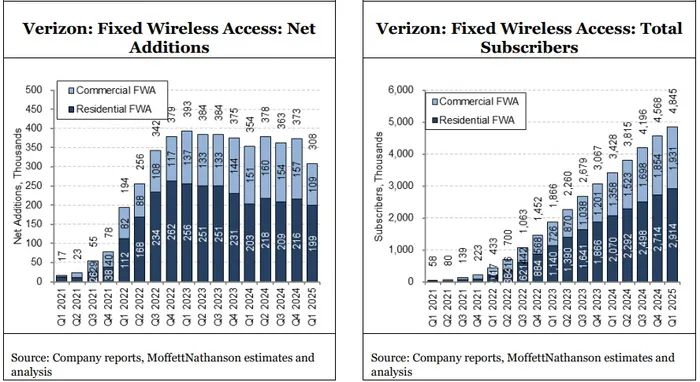Volatile Trump Tax hands Verizon a mixed bag
Verizon is weighing the potential financial impact of President Donald Trump's ever-evolving tariff policies. But CEO Hans Vestberg admits that determining what the exact financial impact will be remains difficult to pinpoint.
Trump's ever-evolving tariff policies are a "moving target," Vestberg said Tuesday on the company's Q1 2025 earnings call when asked for comment.
For now, a "very small portion" of Verizon's capital expenditures through the mid-point of 2025 are exposed to US tariffs, Vestberg said. Verizon's capex guidance of $18.5 billion for full-year 2025 remains intact.
country-specific reciprocal US tariffs (save for China) are currently in the midst of a 90-day delay as Trump and his team try to hammer out new trade deals. Tariffs on popular consumer electronics, including smartphones, are still in a state of flux. While there was an initial exemption on those products, uncertainty arose when Trump later stated that smartphones and computers likely would still face new tariffs.
Vestberg said Verizon will be disciplined about smartphone-related promotions in the near-term, but acknowledged that any tariff-related smartphone costs ultimately will be absorbed by consumers.
"We will not cover any enormous increase on tariffs on handsets," Vestberg said. "That needs to be passed on to the customers. That's the only way to do it, because that's so much money."
But it's still not clear how this will impact Verizon's mobile business and how the company might adjust its strategies. "We assume Verizon's discipline holds as long as competitive intensity for the market holds. If others take up subsidies, Verizon may be forced to also," New Street Research analyst Jonathan Chaplin explained in a research note issued after Verizon's earnings call.
'Small portion' of capex exposed to tariffs
Vestberg said there's little to no tariff exposure for fiber, noting that its fiber business, including labor and product, is US-centric. However, a "small portion" of Verizon's capex tied to wireless, including fixed wireless access (FWA), is imported. That latter portion includes products sourced from companies such as Samsung and Ericsson.
He said Verizon is working with suppliers to help mitigate the effects of US tariffs, but stressed that there's still a lot of uncertainty about how it will all shake out.
"Again, it's too early to say," Vestberg explained. "We don't know where the tariffs are going to go. But I think my team is well prepared for handing all of it."
Analysts are keeping close tabs on how new tariffs might impact Verizon's network buildout plans.
"If tariffs do start to push up equipment prices, we would expect Verizon to modestly slow the pace of deployment to stay within its capex budget for the year. If higher prices persist, we would expect slightly slower deployments in future years also," New Street Research's Chaplin said in a research note issued prior to Verizon's earnings call.
Vestberg said Verizon is ahead of schedule to build an incremental 650,000 Fios passings this year, up from the 450,000 built in 2024. Verizon's long-term goal is to make broadband available to more than 100 million premises in the US, including fiber to 35 million to 40 million premises. Its acquisition of Frontier Communications is in the approval process and expected to close by the first quarter of 2026.
FWA subs still growing, but slowing
Turning to Verizon's broadband business, FWA remains a key growth driver, but the rate of subscriber growth continues to decelerate.
Verizon added 308,000 FWA subs in the quarter, down from year-ago adds of 354,000 subscribers. Analysts were expecting Verizon to add about 332,000 FWA subs.
Verizon's FWA total included a Q1 2025 gain of 199,000 residential FWA customers, down from 203,000 a year earlier, and Q1 2025 gain of 109,000 business FWA subs, down from a gain of 151,000 in the year-ago period.
Verizon ended the quarter with 4.84 million FWA customers – 2.91 million residential and 1.93 million business.

Verizon's FWA residential adds in Q1 "marked the first result below 200K since shortly after they launched the service, and once again below the levels of a year ago," MoffettNathanson analyst Craig Moffett explained in a research note (registration required). "The deceleration marks the sixth straight quarter of YoY lower net additions."
On the wireline side, Verizon added 41,000 residential Fios Internet customers, down from a gain of 49,000 a year ago, ending the quarter with 7.17 million. With DSL losses included, Verizon added 31,000 wireline broadband customers in Q1, ending the quarter with 7.33 million.
With wireline and FWA combined, Verizon added 230,000 residential broadband subs, close to a gain of 239,000 in the year-ago period, ending Q1 with 10.24 million.
Verizon continued to shed video subs. It lost 58,000 residential video subs in Q1, improved from a year-ago loss of 68,000. Verizon ended the quarter with 2.62 million residential Fios video subs.





